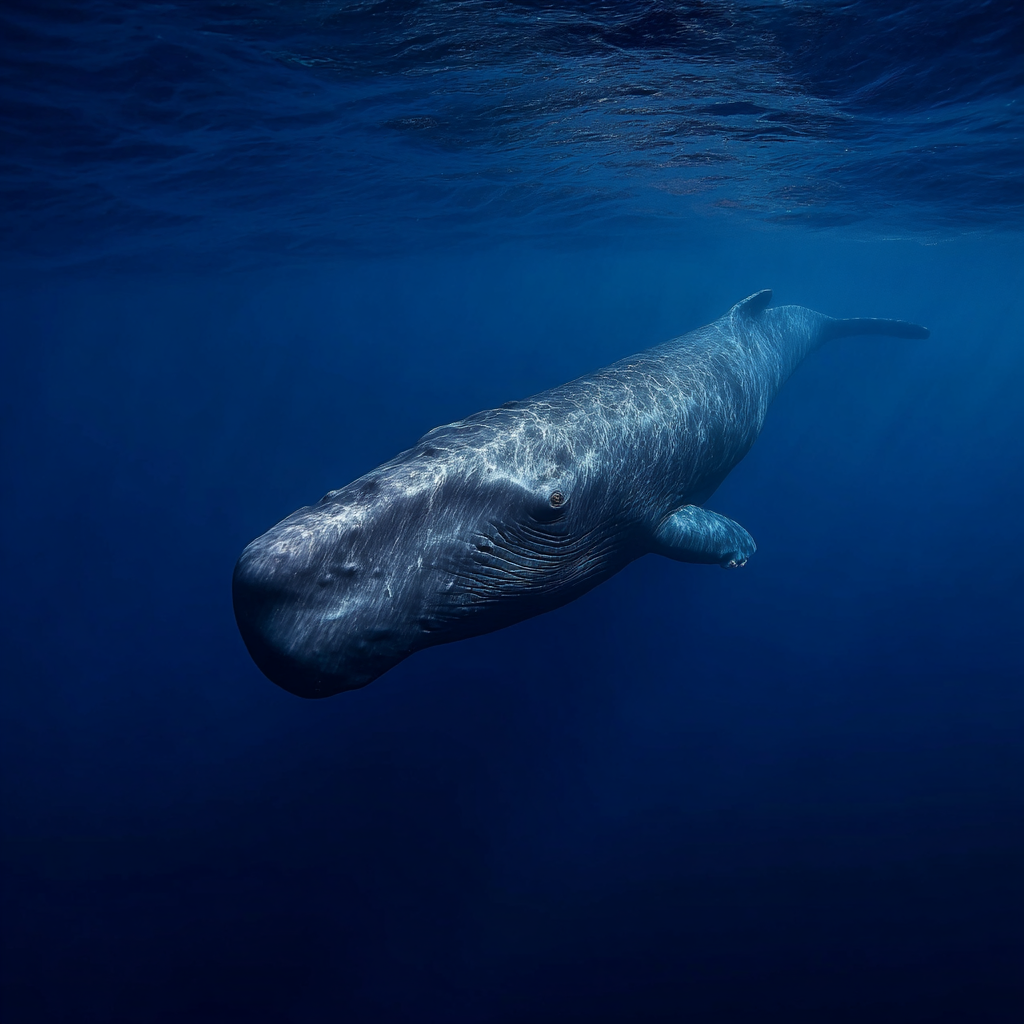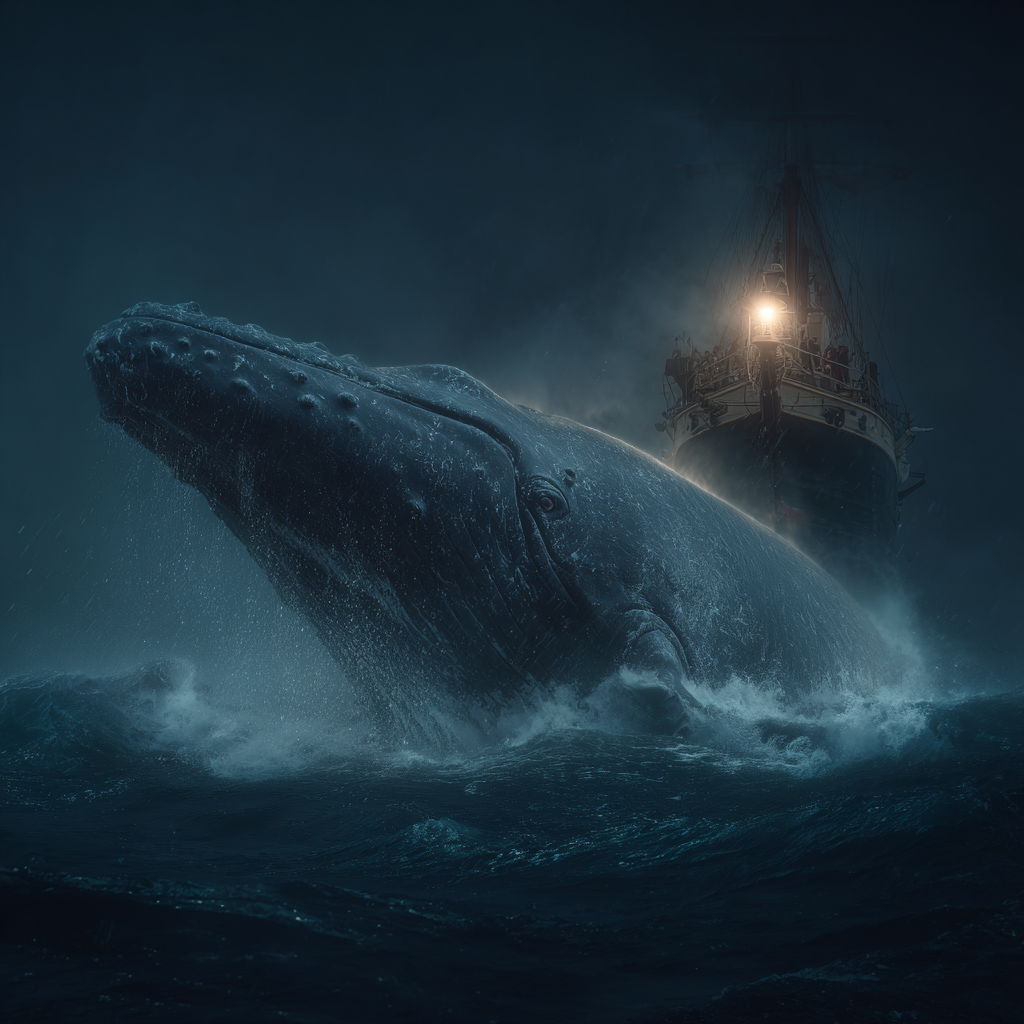Sperm Whale
The Leviathan of the Deep
The Sperm Whale, Physeter macrocephalus, is a creature of superlatives and contradictions. It is the largest toothed predator on Earth, a deep-diving giant that can plunge to depths exceeding 2,000 meters in pursuit of its prey. Yet despite its immense size and power, it is also one of the most socially complex and culturally sophisticated animals in the ocean.
To human culture, the Sperm Whale has long occupied a dual and contradictory identity: it is both the monstrous white whale of Melville's Moby-Dick, a symbol of nature's terrifying indifference, and a highly intelligent, social being whose complex communication system rivals that of any known non-human species. This report seeks to reconcile these two perspectives, examining the biology, behavior, and conservation status of a species that has been both the target of industrial exploitation and the subject of profound scientific fascination.
Biological Overview
Physical Characteristics
- Male Length: Up to 20.7 meters (68 ft)
- Female Length: Up to 12.5 meters (41 ft)
- Male Weight: Up to 57,000 kg (63 tons)
- Female Weight: Up to 24,000 kg (26 tons)
- Head: 1/3 of body length; contains spermaceti organ
Life History
- Lifespan: Up to 70 years (estimated)
- Gestation: 14-16 months
- Calf Size: 4 meters (13 ft) at birth
- Sexual Maturity: Females 7-13 years; males 18+ years
- Calving Interval: Every 4-6 years
Distribution & Population
- Range: All deep oceans, tropical to polar
- Family: Physeteridae
- Global Population: ~200,000-450,000
- Habitat: Deep offshore waters, near continental margins
- Status: Largest toothed whale
Foraging & Diving
- Diet: Primarily squid, including giant squid
- Also Eats: Deep-sea fish, octopus
- Dive Depth: Regular dives 300-800m; max 2,250m+
- Dive Duration: 45-90 minutes typical
- Echolocation: Loudest biological sound (230+ dB)

A sperm whale's massive square head—comprising one-third of its body length and containing the enormous spermaceti organ—is instantly recognizable. This biological sonar array produces the loudest sounds made by any animal on Earth.
Master of the Abyss
The Sperm Whale is the deepest-diving of all the great whales and one of the deepest-diving mammals on the planet. It routinely descends to depths of 300 to 800 meters, but documented dives have reached astonishing depths exceeding 2,250 meters—over 7,000 feet below the surface, where the pressure is crushing and the world is utterly dark.
The Hunt in Darkness
At these depths, the sperm whale hunts in total blackness, navigating and finding prey using the most sophisticated biological sonar system known to science. It produces powerful, directional clicks that can reach 230 decibels, making them the loudest sounds produced by any animal. These clicks bounce off prey items—primarily deep-sea squid—and return as echoes, creating a detailed acoustic image of the whale's surroundings.
The sperm whale's primary prey is the giant squid (Architeuthis dux), creatures that can reach lengths of over 13 meters. The battles between these two titans of the deep ocean are legendary, evidenced by the circular scars left by giant squid suckers found on the skin of many sperm whales. These scars are the marks of an epic struggle that takes place in a realm no human has ever witnessed.

Female sperm whales and their young form tight-knit social units, remaining together for life. Within these pods, complex communication systems and cultural traditions are passed from generation to generation through sophisticated coda dialects.
A Language Beneath the Waves: Communication and Culture
Beyond their physical prowess, sperm whales are profoundly social and culturally sophisticated animals. They live in matrilineal social units, where females and their offspring form stable, long-term bonds. Adult males leave these units when they reach maturity, living solitary lives or forming loose bachelor groups, returning to the female groups only to breed.
The Coda System
Sperm whales communicate using a sophisticated system of short, patterned sequences of clicks known as "codas." These are distinct from the echolocation clicks used for hunting and appear to serve purely social functions. Each social group has its own unique repertoire of codas, creating what researchers call "vocal clans"—groups of whales that share similar coda types and are culturally distinct from other clans, even when they occupy overlapping geographic ranges.
Recent research using advanced AI analysis has revealed that sperm whale codas have a structured, combinatorial nature that researchers are calling a "phonetic alphabet." The whales appear to modulate their clicks with remarkable precision, creating a complex communication system with the potential for a vast vocabulary. This discovery suggests that sperm whales may possess one of the most sophisticated non-human communication systems on Earth, potentially approaching what could be called a "language."
Cultural Transmission
Like orcas, sperm whales demonstrate clear evidence of culture—behaviors and knowledge that are learned socially and passed down through generations rather than being genetically inherited. Different vocal clans have different hunting techniques, social structures, and even different movement patterns. This cultural diversity is maintained over generations, creating parallel societies within the same species.

Ship strikes pose an ongoing threat to sperm whales, particularly in busy shipping lanes. Combined with entanglement in fishing gear, ocean noise pollution, and the lingering effects of centuries of whaling, these giants face a precarious future despite international protections.
Moby-Dick and the Industrial Whale
The sperm whale's place in human imagination is dominated by Herman Melville's 1851 novel Moby-Dick, the story of Captain Ahab's obsessive quest to kill a giant white sperm whale. The novel immortalized the sperm whale as a symbol of nature's sublime power and terrifying indifference, a creature both majestic and monstrous.
But Melville's whale was also a product of an industrial age. Sperm whales were hunted for centuries for their spermaceti oil—a waxy substance found in their massive heads that was prized for use in lamps, lubricants, and cosmetics. At the height of the whaling era in the 19th century, thousands of sperm whales were killed each year. The global population was devastated, with some estimates suggesting that over 1 million sperm whales were killed between 1800 and 1987.
Recovery and Remaining Threats
Following the implementation of the International Whaling Commission's moratorium on commercial whaling in 1986, sperm whale populations have shown signs of recovery. The species is now listed as "Vulnerable" on the IUCN Red List, an improvement from its previous "Endangered" status. Current global population estimates range from 200,000 to 450,000 individuals.
Ongoing Threats
Ship Strikes: Collisions with large vessels remain a significant source of mortality, particularly in busy shipping lanes.
Entanglement: Fishing gear, including longlines and drift nets, poses an entanglement risk.
Noise Pollution: Underwater noise from shipping, sonar, and seismic surveys can interfere with communication and echolocation.
Plastic Pollution: Ingestion of plastic debris has been documented in some populations.
Climate Change: Shifts in ocean temperature and productivity may affect the distribution and abundance of their deep-sea prey.
The sperm whale's story is one of resilience, but also of fragility. Despite their size, intelligence, and deep-sea mastery, they remain vulnerable to human impacts. Protecting them requires international cooperation, continued research, and a commitment to reducing the threats that still haunt the ocean's deepest reaches.
References
- NOAA Fisheries. Sperm Whale. https://www.fisheries.noaa.gov/species/sperm-whale
- Alaska Department of Fish and Game. Sperm Whale Species Profile. https://www.adfg.alaska.gov/index.cfm?adfg=spermwhale.main
- Gero, S. et al. Contextual and combinatorial structure in sperm whale vocalisations. Nature Communications 15, 2020 (2024). https://www.nature.com/articles/s41467-024-47221-8
- Whitehead, H. Sperm whale societies: evolution, culture and conservation. The University of Chicago Press, 2003.
- Cantor, M. & Whitehead, H. The interplay between social networks and culture: theoretically and among whales and dolphins. Philosophical Transactions of the Royal Society B 368 (2013). https://royalsocietypublishing.org/doi/10.1098/rstb.2012.0340
- Project CETI. The sperm whale 'phonetic alphabet' revealed by AI. May 2024. https://www.projectceti.org/
- NPR. Scientists used AI to decode sperm whale calls. Their findings are mind-blowing. May 7, 2024. https://www.npr.org/2024/05/07/1249546255/sperm-whale-communication-ai-language
- Global News. Sperm whales' clicking dialects are evidence of 'non human culture,' say scientists. May 12, 2024. https://globalnews.ca/news/9134675/sperm-whales-dialects-culture-study/
- The Dominica Sperm Whale Project. Conservation Issues. http://www.thespermwhaleproject.org/threats
- Whale & Dolphin Conservation. Sperm Whale. https://us.whales.org/whales-dolphins/species-guide/sperm-whale/
- Wikipedia. Sperm whale. https://en.wikipedia.org/wiki/Sperm_whale
- WWF. Sperm Whale. https://www.worldwildlife.org/species/sperm-whale